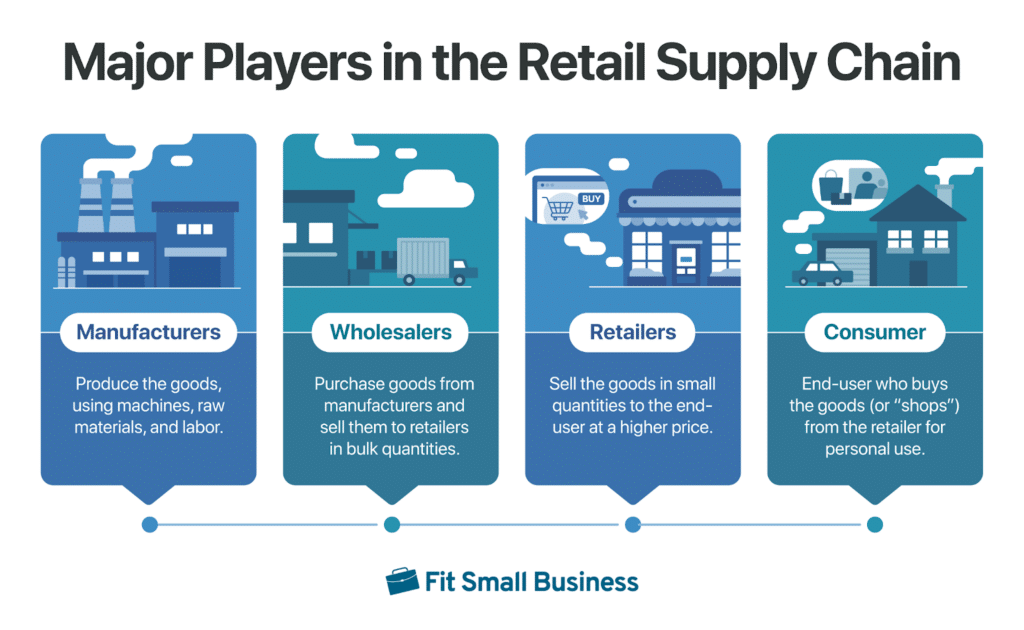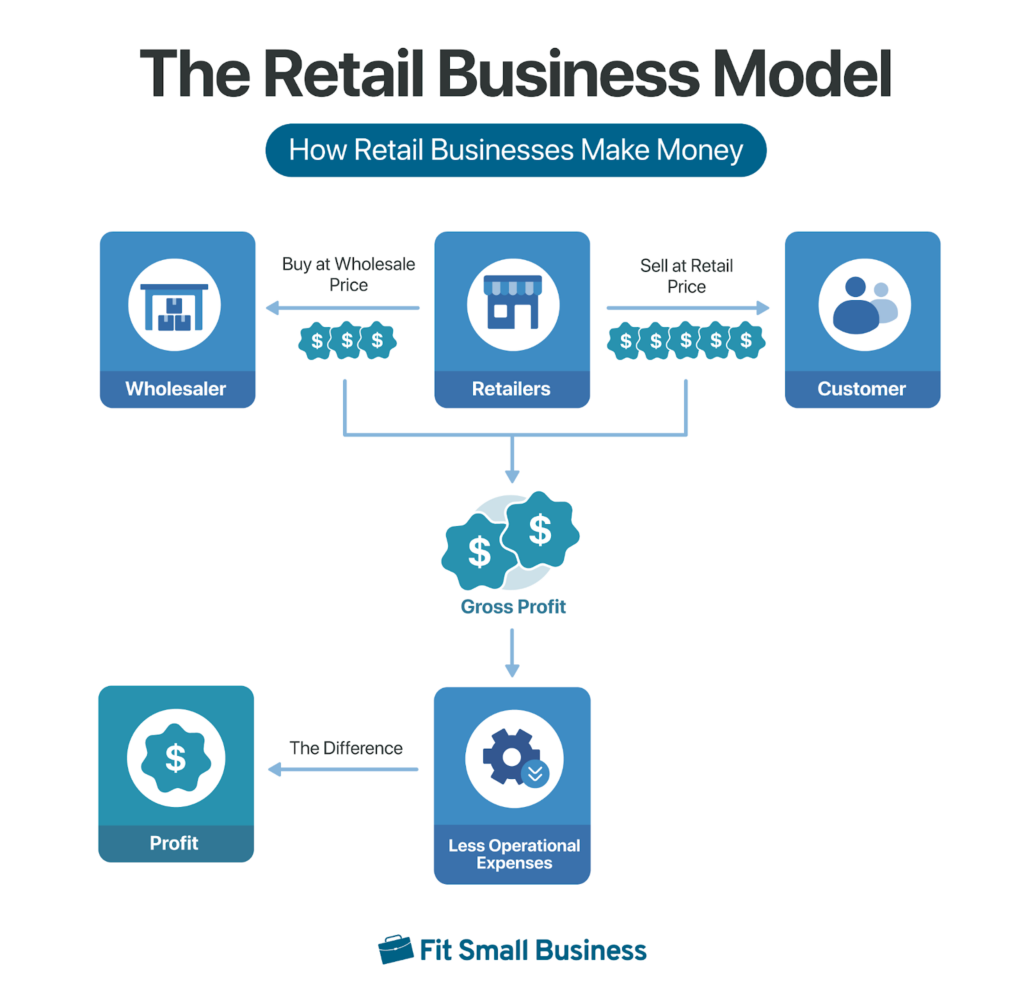Retail is a type of business where merchants sell products to consumers for personal use. Retailing is the act of conducting retail business. Ecommerce and omnichannel selling have blurred the lines of physical and online retail, so retail is a term that often encompasses all selling of goods—digitally, in-store, or elsewhere.
In this guide, you will learn what retail is, how it works, the many types of retail that exist, and the players in the retail supply chain.
Retailing is selling goods or services to customers for use.
A retailer is the merchant or business individual shoppers buy goods from. Retailers typically buy products from a manufacturer or a wholesaler and sell these items to consumers in small quantities.
Simply put, retailing is the act of selling goods directly to the end user (customer). A retailer is the performer of this action (retailing).
How Retail Works
Retail works from a supply chain consisting of major players—manufacturers, wholesalers, retailers, and consumers. The retail supply chain covers the distribution of products from production (manufacturing) to consumption (buying/using).
Here’s how it looks like, typically:
- Manufacturers produce goods from raw materials
- Wholesalers or distributors buy goods from manufacturers
- Retailers purchase goods from wholesalers
- Retailers sell goods in small quantities to end-consumers
- Consumers purchase goods for personal use

Note, though, that a retail supply chain can skip a major player in between but it always ends up with the consumer buying goods.
Types of Retail
There are many retail types out there, especially as the term has become more flexible and encompassing.
However, the following are not considered retail:
- Service-based businesses that don’t sell any products, such as dog grooming, beauty salons, etc.
- Multilevel marketing (MLM) schemes with in-person networking and selling
- Utilities or services such as internet, water, electricity, etc.
Permanent Brick-and-Mortar
Perhaps the most traditional type of retail is the permanent brick-and-mortar store. Businesses may own or even lease the retail space with plans to be there for a long time. Permanent retail shops might sell their own items or sell items from other suppliers—or a mixture of both.
Related:
- Store Management: How to Manage a Retail Store for Success
- Retail Store Design Ideas to Increase Sales
Pop-up
A pop-up shop is a temporary retail activation that may last a single day or for several months. It is an impermanent retail store that allows people to interact with your brand and products in person. Pop-up shops are great for building buzz, testing or entering new markets, and experimenting with retail before investing in a full-blown store.
Markets
Markets are also retail opportunities, allowing merchants to set up small tables or booths and sell directly to consumers. They could be regular community-based or farmers markets or one-time special events. The risk is small when it comes to selling in markets, as you typically only need to pay a small vendor fee.
Event-based Retail
Other events also offer a venue for retailing. You might participate in festivals, fairs, concerts, sporting events, or other occasions allowing vendors. As with markets, you don’t have to worry about marketing to draw foot traffic—the event will do that for you. It’s all about standing out among the other vendors.
Online
Ecommerce, online retail—or “e-tail”—is when you sell products digitally. This could be through your own online store or via third-party marketplaces like Amazon, Etsy, Walmart, or Target. Many retailers sell both online and in person—this is an excellent way to drive more sales. Mobile shopping, a part of mobile commerce, in particular has been increasingly the preferred choice of shopping online by consumers.
Did you know? The first Black Friday wasn’t a retail shopping event. It originally highlighted the financial crisis and crash of Wall Street in 1869. It was reinvented in the 1980s after several attempts. Now, it’s one of the biggest retail sales days of the year. Explore Black Friday shopping statistics.
How Retail Businesses Make Money (Profit)
Retailers make money by procuring large quantities of a product at a lower price from a wholesaler or manufacturer and then selling it to the general public (consumers) at a higher price. They can sell it at a higher price since consumers typically buy in smaller quantities.
Retail businesses have different operations which incur expenses or overhead costs. Retailers take these costs from the sales revenue and what is left is their profit.

Importance of Retail
The retail industry supports 52 million jobs in the US—about one in four American jobs is supported by retail. Part-time work plays a crucial role in the US economy, and 17% of part-time workers work in retail. Six in 10 Americans have worked a retail job, and 32% of all Americans’ first jobs were in retail.
There are 4.2 million retail establishments that have a $1.6 trillion impact on the US’ GDP.
As such, the retail sector is considered to be the largest private sector employer in the US. This is why retail trends and forecasts are always anticipated, even by people outside the industry.

(Source: National Retail Federation NRF)
What Is Retail Frequently Asked Questions (FAQs)
Retail businesses are those that sell items or services to consumers for their personal use. Retail businesses traditionally sell products in-store (brick-and-mortar and storefront) but these days they can also conduct their business by selling online or over the phone and then having the purchased goods shipped to the customer.
Retail is the sale of goods and services in small quantities to consumers for their personal consumption.
Retailing is the process of distributing obtained goods or services by a retailer to sell them to customers for use.
A retail trade business involves purchasing goods from a wholesaler or manufacturer and selling them to consumers for profit.
Bottom Line
Retail is a business model that’s been around for a while, and though it’s gone through many changes, it’s not heading anywhere soon. There are plenty of opportunities for small businesses of all types in all kinds of niches. It’s a matter of determining which opportunity is right for you and going for it.